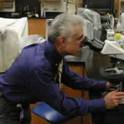Article
Targeting plasminogen activator inhibitor-1 in tetracycline-induced pleural injury in rabbits
american journal of physiology lung cellular and molecular physiology
(2017)
Abstract
Elevated active plasminogen activator inhibitor-1 (PAI-1) has an adverse effect on the outcomes of intrapleural fibrinolytic therapy (IPFT) in tetracycline-induced pleural injury in rabbits. To enhance IPFT with prourokinase (scuPA), two mechanistically distinct approaches to targeting PAI-1 were tested: slowing its reaction with urokinase (uPA) and monoclonal antibody (mAb)-mediated PAI-1 inactivation. Removing positively charged residues at the "PAI-1 docking site" (179RHRGGS184→179AAAAAA184) of uPA results in a 60-fold decrease in the rate of inhibition by PAI-1. Mutant prourokinase (0.0625-0.5 mg/kg; n = 12) showed efficacy comparable to wild-type scuPA and did not change IPFT outcomes ( P > 0.05). Notably, the rate of PAI-1-independent intrapleural inactivation of mutant uPA was 2 times higher ( P < 0.05) than that of the wild-type enzyme. Trapping PAI-1 in a "molecular sandwich"-type complex with catalytically inactive two-chain urokinase with Ser195Ala substitution (S195A-tcuPA; 0.1 and 0.5 mg/kg) did not improve the efficacy of IPFT with scuPA (0.0625-0.5 mg/kg; n = 11). IPFT failed in the presence of MA-56A7C10 (0.5 mg/kg; n = 2), which forms a stable intrapleural molecular sandwich complex, allowing active PAI-1 to accumulate by blocking its transition to a latent form. In contrast, inactivation of PAI-1 by accelerating the active-to-latent transition mediated by mAb MA-33B8 (0.5 mg/kg; n = 2) improved the efficacy of IPFT with scuPA (0.25 mg/kg). Thus, under conditions of slow (4-8 h) fibrinolysis in tetracycline-induced pleural injury in rabbits, only the inactivation of PAI-1, but not a decrease in the rate of its reaction with uPA, enhances IPFT. Therefore the rate of fibrinolysis, which varies in different pathologic states, could affect the selection of PAI-1 inhibitors to enhance fibrinolytic therapy.
Keywords
- active plasminogen activator inhibitor-1; animal model; fibrinolytic therapy; molecular target; prourokinase
Disciplines
Publication Date
August 31, 2017
Citation Information
G. G. Florova, Ali Azghani, S. Karandashova, C. Schaefer, et al.. "Targeting plasminogen activator inhibitor-1 in tetracycline-induced pleural injury in rabbits" american journal of physiology lung cellular and molecular physiology Vol. 314 Iss. 1 (2017) Available at: http://works.bepress.com/ali-azghani/101/
